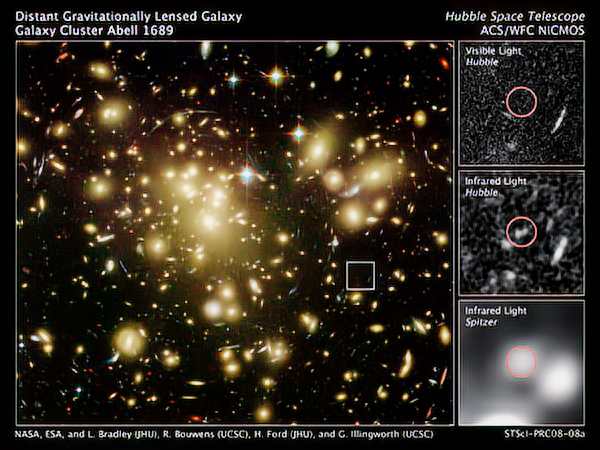Astronomers have potentially uncovered the oldest object ever observed in the cosmos—a galaxy from a distant past, 13.1 billion years ago. This ancient galaxy, hidden in a recent Hubble Space Telescope image, represents a time when the universe was barely 600 million years old, making it the earliest and most distant galaxy observed to date.
The discovery, detailed in a study published online Wednesday in Nature, was made by European astronomers who analyzed a faint smudge of light in a Hubble photograph. According to Matthew Lehnert of the Paris Observatory, the galaxy is so ancient that it likely no longer exists in its original form, having merged with other galaxies over the eons.
“We’re observing the universe at just 1/20th of its current age,” Lehnert explained. “In human terms, it’s like looking at a 4-year-old child in the life span of an adult.” The galaxy’s extreme distance means that what we see is a snapshot of its early years, potentially as young as 100 million years old when the light first began its journey.
The discovery follows earlier estimates of the galaxy’s age, which placed it between 600 to 800 million years after the Big Bang. This estimate was based on initial observations of fuzzy points of light in the Hubble image presented at an astronomy conference earlier this year. The new study refines this age by focusing on the galaxy’s light signatures, particularly the cooling hydrogen gas, and represents a significant step in confirming these findings.
Garth Illingworth of the University of California, Santa Cruz, who was behind the Hubble image, lauded the study for its confirmation of the galaxy’s age using a different method. “It’s amazing that we can get such accurate results for such faint objects,” Illingworth noted.
The galaxy currently lacks a formal name and is referred to as “the high red-shift blob” by researchers. The term “red-shift” refers to the stretching of light waves as they travel across the universe, indicating the vast distance and age of the object. The long journey of light allows astronomers to observe the galaxy as it appeared 13.1 billion years ago, providing a glimpse into a formative period of cosmic history.
Notably, this discovery aligns with existing theories about the formation of the first stars and galaxies. The high-red-shift galaxy’s characteristics—its youthful, massive blue stars and its lack of carbon and heavier metals—suggest that it formed shortly after the first cosmic objects. This finding brings astronomers closer to observing the very beginning of the universe.
Richard Ellis, an astronomy professor at the California Institute of Technology who was not part of the discovery team, described the significance of the find. “We’re nearly at the edge of seeing the very first objects that formed,” Ellis said. “In human terms, 100 million years seems like a long time, but in the context of astronomical timescales, it’s just a blink.”
Despite the excitement, some experts remain cautious. Previous claims about the age of distant space objects have sometimes been challenged, and skepticism persists. Nevertheless, even critics acknowledge the study’s importance and its contribution to our understanding of the early universe.
The discovery of this ancient galaxy underscores the advancements in astronomical technology and observational techniques. By peering further into the depths of space, scientists continue to push the boundaries of our knowledge about the universe’s infancy.
As astronomers continue to explore these distant galaxies, they unravel more about the early days of the cosmos and the formation of the universe’s first structures. The journey to understand the origins of our universe is ongoing, with each new discovery adding pieces to the grand cosmic puzzle.

